Early Childhood Education and Care: Development, Play, and Planning
VerifiedAdded on 2023/06/03
|11
|2500
|173
Report
AI Summary
This report delves into the multifaceted aspects of early childhood education and care, encompassing developmental needs, the significance of play, and the design of effective learning centers. The report begins by outlining the physiological, emotional, and social needs of children, highlighting the impact of factors like nutrition, safety, and emotional support. It then explores the crucial role of play in child development, discussing various methods to encourage play and the stages of social play as defined by Mildred Parten. Furthermore, the report provides practical scenarios with activity suggestions tailored for different age groups, along with detailed safety guidelines. Finally, the report culminates in a comprehensive analysis of planning a learning center, including the identification of five key learning centers, a focus on an art center, and the resources, instructions, and safety measures required to create a stimulating and secure environment for preschool children. The report also includes a planning sheet and a list of references.
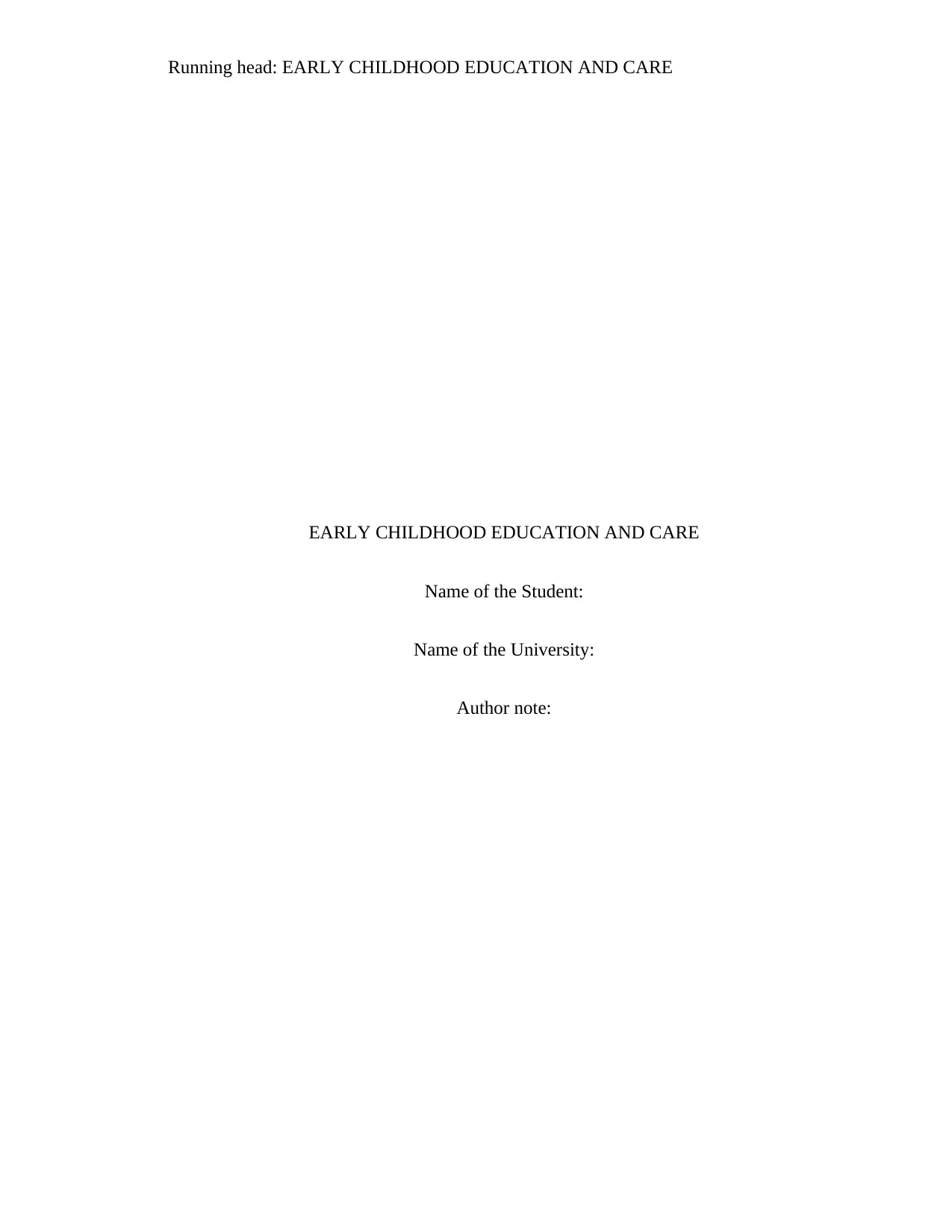
Running head: EARLY CHILDHOOD EDUCATION AND CARE
EARLY CHILDHOOD EDUCATION AND CARE
Name of the Student:
Name of the University:
Author note:
EARLY CHILDHOOD EDUCATION AND CARE
Name of the Student:
Name of the University:
Author note:
Paraphrase This Document
Need a fresh take? Get an instant paraphrase of this document with our AI Paraphraser
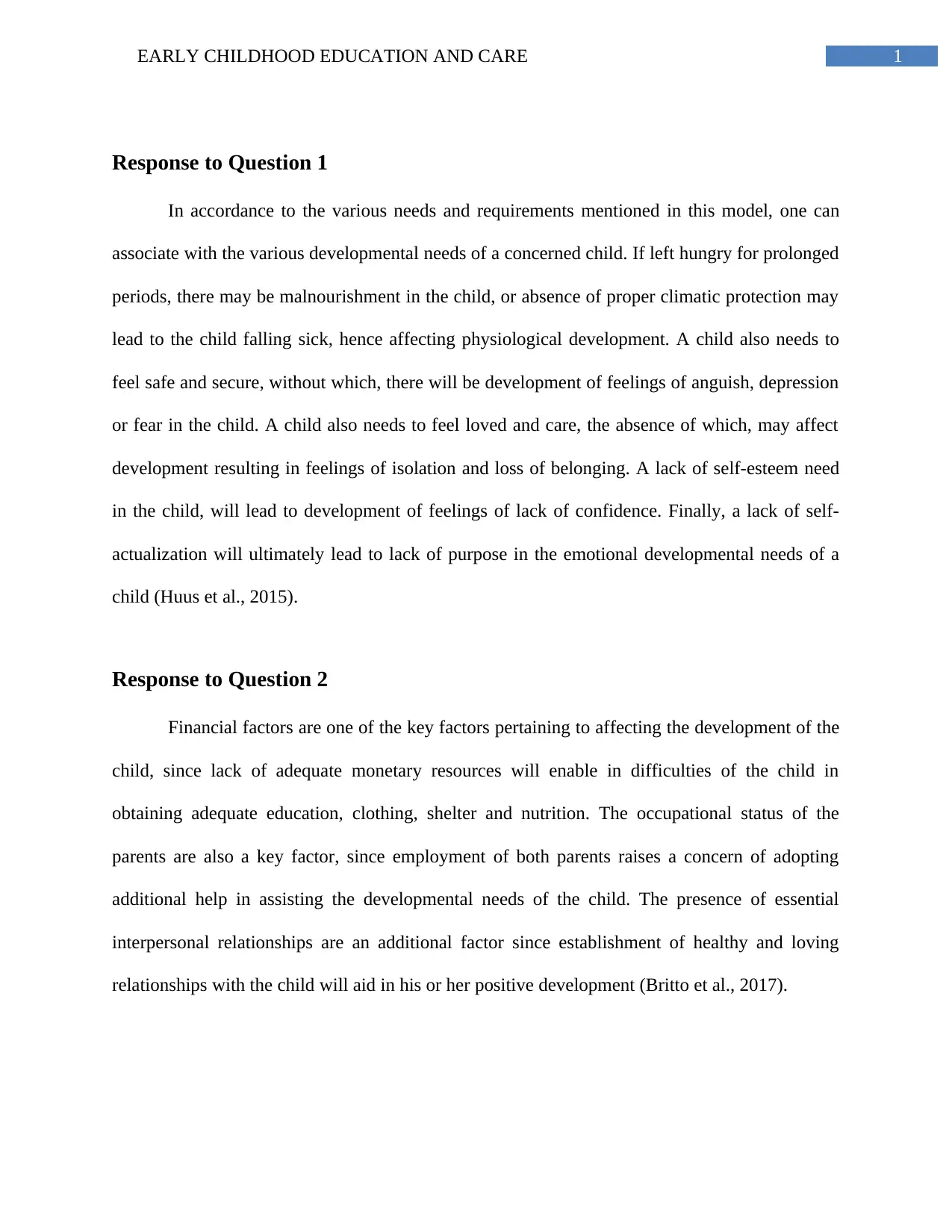
1EARLY CHILDHOOD EDUCATION AND CARE
Response to Question 1
In accordance to the various needs and requirements mentioned in this model, one can
associate with the various developmental needs of a concerned child. If left hungry for prolonged
periods, there may be malnourishment in the child, or absence of proper climatic protection may
lead to the child falling sick, hence affecting physiological development. A child also needs to
feel safe and secure, without which, there will be development of feelings of anguish, depression
or fear in the child. A child also needs to feel loved and care, the absence of which, may affect
development resulting in feelings of isolation and loss of belonging. A lack of self-esteem need
in the child, will lead to development of feelings of lack of confidence. Finally, a lack of self-
actualization will ultimately lead to lack of purpose in the emotional developmental needs of a
child (Huus et al., 2015).
Response to Question 2
Financial factors are one of the key factors pertaining to affecting the development of the
child, since lack of adequate monetary resources will enable in difficulties of the child in
obtaining adequate education, clothing, shelter and nutrition. The occupational status of the
parents are also a key factor, since employment of both parents raises a concern of adopting
additional help in assisting the developmental needs of the child. The presence of essential
interpersonal relationships are an additional factor since establishment of healthy and loving
relationships with the child will aid in his or her positive development (Britto et al., 2017).
Response to Question 1
In accordance to the various needs and requirements mentioned in this model, one can
associate with the various developmental needs of a concerned child. If left hungry for prolonged
periods, there may be malnourishment in the child, or absence of proper climatic protection may
lead to the child falling sick, hence affecting physiological development. A child also needs to
feel safe and secure, without which, there will be development of feelings of anguish, depression
or fear in the child. A child also needs to feel loved and care, the absence of which, may affect
development resulting in feelings of isolation and loss of belonging. A lack of self-esteem need
in the child, will lead to development of feelings of lack of confidence. Finally, a lack of self-
actualization will ultimately lead to lack of purpose in the emotional developmental needs of a
child (Huus et al., 2015).
Response to Question 2
Financial factors are one of the key factors pertaining to affecting the development of the
child, since lack of adequate monetary resources will enable in difficulties of the child in
obtaining adequate education, clothing, shelter and nutrition. The occupational status of the
parents are also a key factor, since employment of both parents raises a concern of adopting
additional help in assisting the developmental needs of the child. The presence of essential
interpersonal relationships are an additional factor since establishment of healthy and loving
relationships with the child will aid in his or her positive development (Britto et al., 2017).
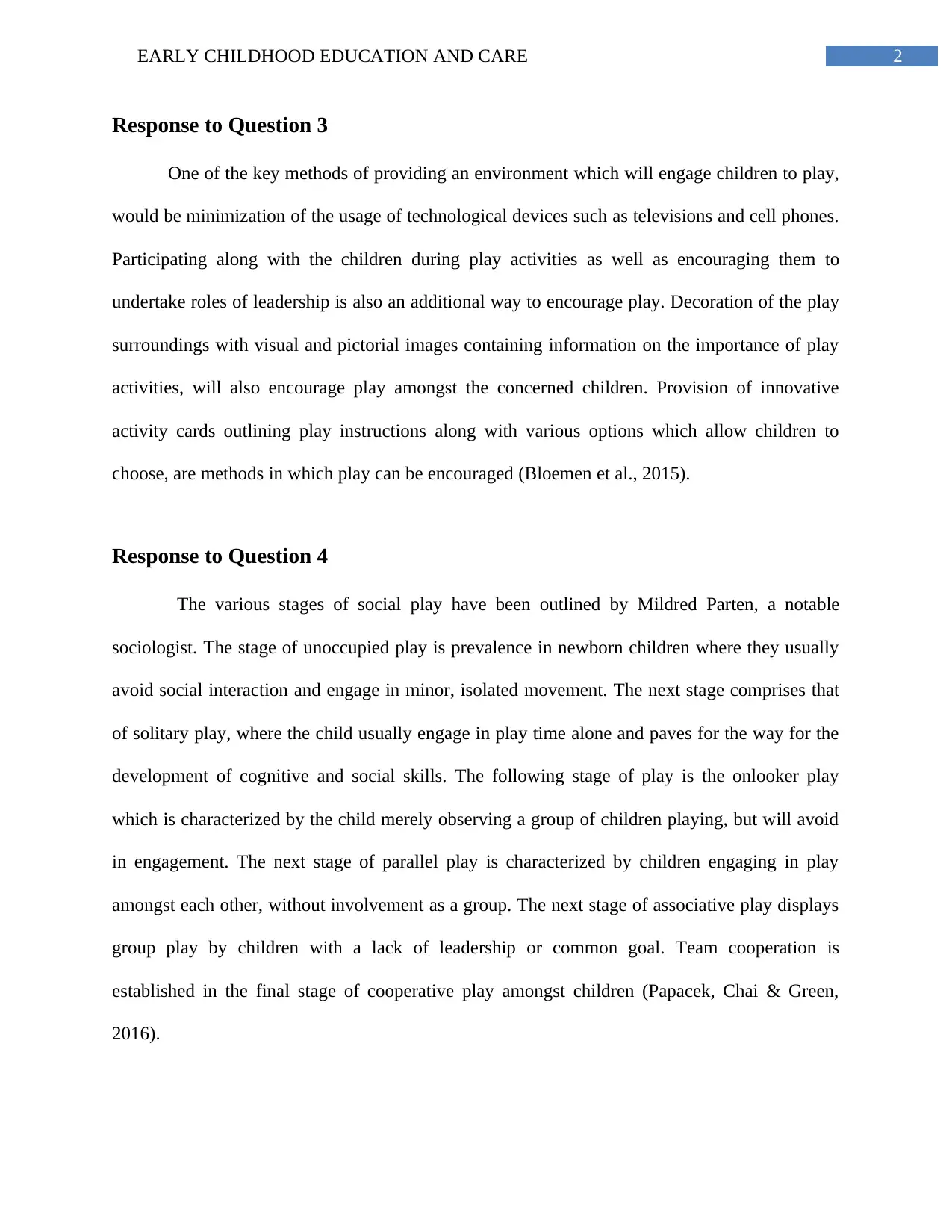
2EARLY CHILDHOOD EDUCATION AND CARE
Response to Question 3
One of the key methods of providing an environment which will engage children to play,
would be minimization of the usage of technological devices such as televisions and cell phones.
Participating along with the children during play activities as well as encouraging them to
undertake roles of leadership is also an additional way to encourage play. Decoration of the play
surroundings with visual and pictorial images containing information on the importance of play
activities, will also encourage play amongst the concerned children. Provision of innovative
activity cards outlining play instructions along with various options which allow children to
choose, are methods in which play can be encouraged (Bloemen et al., 2015).
Response to Question 4
The various stages of social play have been outlined by Mildred Parten, a notable
sociologist. The stage of unoccupied play is prevalence in newborn children where they usually
avoid social interaction and engage in minor, isolated movement. The next stage comprises that
of solitary play, where the child usually engage in play time alone and paves for the way for the
development of cognitive and social skills. The following stage of play is the onlooker play
which is characterized by the child merely observing a group of children playing, but will avoid
in engagement. The next stage of parallel play is characterized by children engaging in play
amongst each other, without involvement as a group. The next stage of associative play displays
group play by children with a lack of leadership or common goal. Team cooperation is
established in the final stage of cooperative play amongst children (Papacek, Chai & Green,
2016).
Response to Question 3
One of the key methods of providing an environment which will engage children to play,
would be minimization of the usage of technological devices such as televisions and cell phones.
Participating along with the children during play activities as well as encouraging them to
undertake roles of leadership is also an additional way to encourage play. Decoration of the play
surroundings with visual and pictorial images containing information on the importance of play
activities, will also encourage play amongst the concerned children. Provision of innovative
activity cards outlining play instructions along with various options which allow children to
choose, are methods in which play can be encouraged (Bloemen et al., 2015).
Response to Question 4
The various stages of social play have been outlined by Mildred Parten, a notable
sociologist. The stage of unoccupied play is prevalence in newborn children where they usually
avoid social interaction and engage in minor, isolated movement. The next stage comprises that
of solitary play, where the child usually engage in play time alone and paves for the way for the
development of cognitive and social skills. The following stage of play is the onlooker play
which is characterized by the child merely observing a group of children playing, but will avoid
in engagement. The next stage of parallel play is characterized by children engaging in play
amongst each other, without involvement as a group. The next stage of associative play displays
group play by children with a lack of leadership or common goal. Team cooperation is
established in the final stage of cooperative play amongst children (Papacek, Chai & Green,
2016).
⊘ This is a preview!⊘
Do you want full access?
Subscribe today to unlock all pages.

Trusted by 1+ million students worldwide
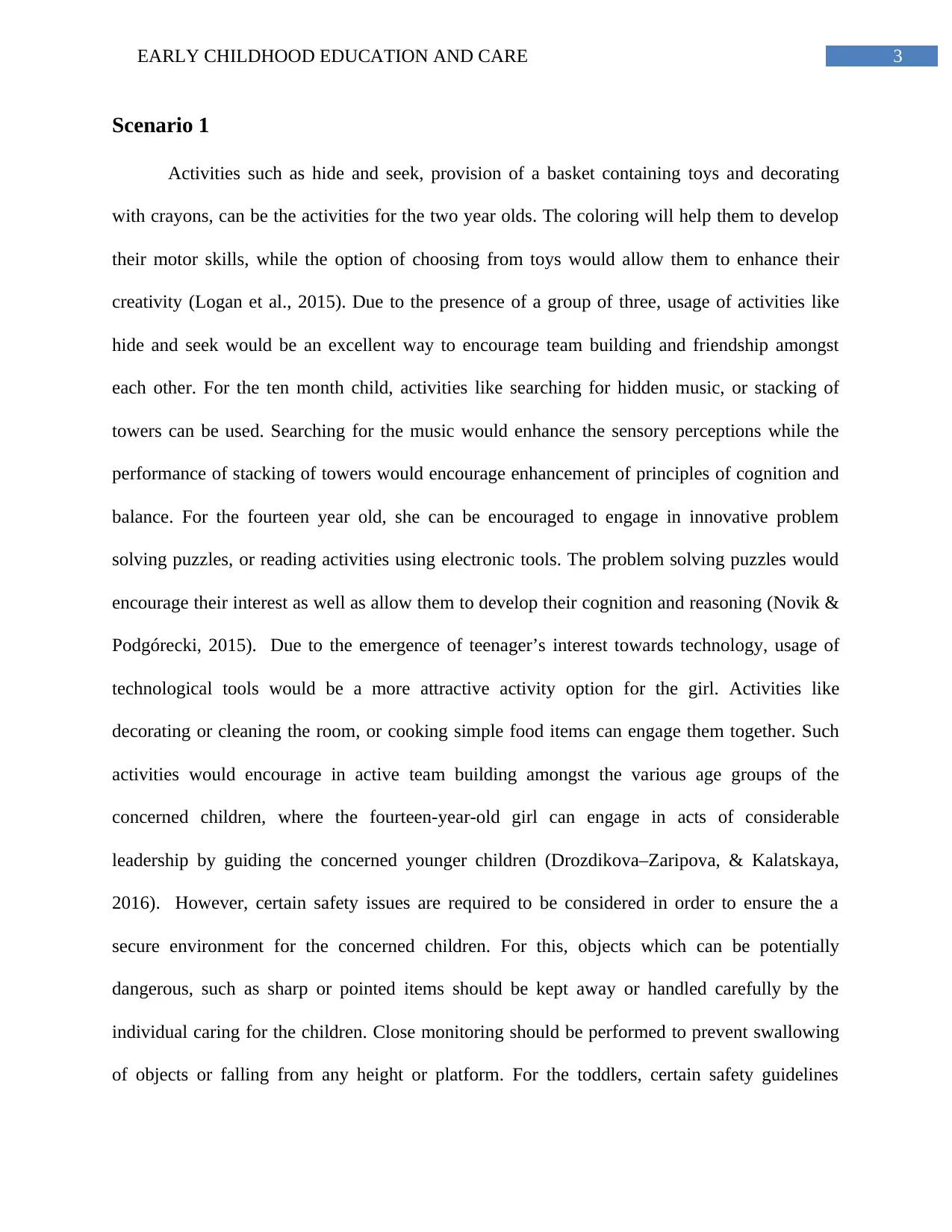
3EARLY CHILDHOOD EDUCATION AND CARE
Scenario 1
Activities such as hide and seek, provision of a basket containing toys and decorating
with crayons, can be the activities for the two year olds. The coloring will help them to develop
their motor skills, while the option of choosing from toys would allow them to enhance their
creativity (Logan et al., 2015). Due to the presence of a group of three, usage of activities like
hide and seek would be an excellent way to encourage team building and friendship amongst
each other. For the ten month child, activities like searching for hidden music, or stacking of
towers can be used. Searching for the music would enhance the sensory perceptions while the
performance of stacking of towers would encourage enhancement of principles of cognition and
balance. For the fourteen year old, she can be encouraged to engage in innovative problem
solving puzzles, or reading activities using electronic tools. The problem solving puzzles would
encourage their interest as well as allow them to develop their cognition and reasoning (Novik &
Podgórecki, 2015). Due to the emergence of teenager’s interest towards technology, usage of
technological tools would be a more attractive activity option for the girl. Activities like
decorating or cleaning the room, or cooking simple food items can engage them together. Such
activities would encourage in active team building amongst the various age groups of the
concerned children, where the fourteen-year-old girl can engage in acts of considerable
leadership by guiding the concerned younger children (Drozdikova–Zaripova, & Kalatskaya,
2016). However, certain safety issues are required to be considered in order to ensure the a
secure environment for the concerned children. For this, objects which can be potentially
dangerous, such as sharp or pointed items should be kept away or handled carefully by the
individual caring for the children. Close monitoring should be performed to prevent swallowing
of objects or falling from any height or platform. For the toddlers, certain safety guidelines
Scenario 1
Activities such as hide and seek, provision of a basket containing toys and decorating
with crayons, can be the activities for the two year olds. The coloring will help them to develop
their motor skills, while the option of choosing from toys would allow them to enhance their
creativity (Logan et al., 2015). Due to the presence of a group of three, usage of activities like
hide and seek would be an excellent way to encourage team building and friendship amongst
each other. For the ten month child, activities like searching for hidden music, or stacking of
towers can be used. Searching for the music would enhance the sensory perceptions while the
performance of stacking of towers would encourage enhancement of principles of cognition and
balance. For the fourteen year old, she can be encouraged to engage in innovative problem
solving puzzles, or reading activities using electronic tools. The problem solving puzzles would
encourage their interest as well as allow them to develop their cognition and reasoning (Novik &
Podgórecki, 2015). Due to the emergence of teenager’s interest towards technology, usage of
technological tools would be a more attractive activity option for the girl. Activities like
decorating or cleaning the room, or cooking simple food items can engage them together. Such
activities would encourage in active team building amongst the various age groups of the
concerned children, where the fourteen-year-old girl can engage in acts of considerable
leadership by guiding the concerned younger children (Drozdikova–Zaripova, & Kalatskaya,
2016). However, certain safety issues are required to be considered in order to ensure the a
secure environment for the concerned children. For this, objects which can be potentially
dangerous, such as sharp or pointed items should be kept away or handled carefully by the
individual caring for the children. Close monitoring should be performed to prevent swallowing
of objects or falling from any height or platform. For the toddlers, certain safety guidelines
Paraphrase This Document
Need a fresh take? Get an instant paraphrase of this document with our AI Paraphraser
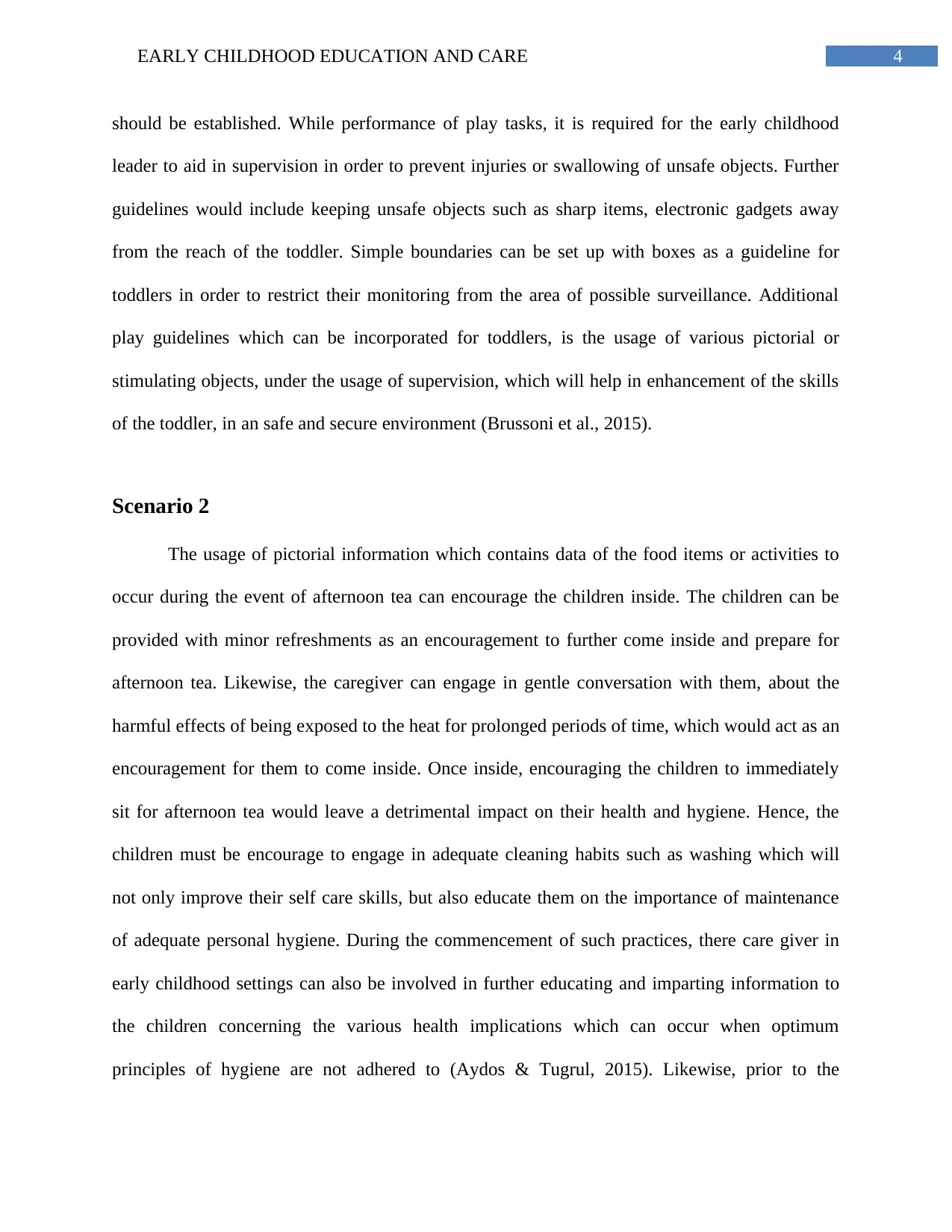
4EARLY CHILDHOOD EDUCATION AND CARE
should be established. While performance of play tasks, it is required for the early childhood
leader to aid in supervision in order to prevent injuries or swallowing of unsafe objects. Further
guidelines would include keeping unsafe objects such as sharp items, electronic gadgets away
from the reach of the toddler. Simple boundaries can be set up with boxes as a guideline for
toddlers in order to restrict their monitoring from the area of possible surveillance. Additional
play guidelines which can be incorporated for toddlers, is the usage of various pictorial or
stimulating objects, under the usage of supervision, which will help in enhancement of the skills
of the toddler, in an safe and secure environment (Brussoni et al., 2015).
Scenario 2
The usage of pictorial information which contains data of the food items or activities to
occur during the event of afternoon tea can encourage the children inside. The children can be
provided with minor refreshments as an encouragement to further come inside and prepare for
afternoon tea. Likewise, the caregiver can engage in gentle conversation with them, about the
harmful effects of being exposed to the heat for prolonged periods of time, which would act as an
encouragement for them to come inside. Once inside, encouraging the children to immediately
sit for afternoon tea would leave a detrimental impact on their health and hygiene. Hence, the
children must be encourage to engage in adequate cleaning habits such as washing which will
not only improve their self care skills, but also educate them on the importance of maintenance
of adequate personal hygiene. During the commencement of such practices, there care giver in
early childhood settings can also be involved in further educating and imparting information to
the children concerning the various health implications which can occur when optimum
principles of hygiene are not adhered to (Aydos & Tugrul, 2015). Likewise, prior to the
should be established. While performance of play tasks, it is required for the early childhood
leader to aid in supervision in order to prevent injuries or swallowing of unsafe objects. Further
guidelines would include keeping unsafe objects such as sharp items, electronic gadgets away
from the reach of the toddler. Simple boundaries can be set up with boxes as a guideline for
toddlers in order to restrict their monitoring from the area of possible surveillance. Additional
play guidelines which can be incorporated for toddlers, is the usage of various pictorial or
stimulating objects, under the usage of supervision, which will help in enhancement of the skills
of the toddler, in an safe and secure environment (Brussoni et al., 2015).
Scenario 2
The usage of pictorial information which contains data of the food items or activities to
occur during the event of afternoon tea can encourage the children inside. The children can be
provided with minor refreshments as an encouragement to further come inside and prepare for
afternoon tea. Likewise, the caregiver can engage in gentle conversation with them, about the
harmful effects of being exposed to the heat for prolonged periods of time, which would act as an
encouragement for them to come inside. Once inside, encouraging the children to immediately
sit for afternoon tea would leave a detrimental impact on their health and hygiene. Hence, the
children must be encourage to engage in adequate cleaning habits such as washing which will
not only improve their self care skills, but also educate them on the importance of maintenance
of adequate personal hygiene. During the commencement of such practices, there care giver in
early childhood settings can also be involved in further educating and imparting information to
the children concerning the various health implications which can occur when optimum
principles of hygiene are not adhered to (Aydos & Tugrul, 2015). Likewise, prior to the
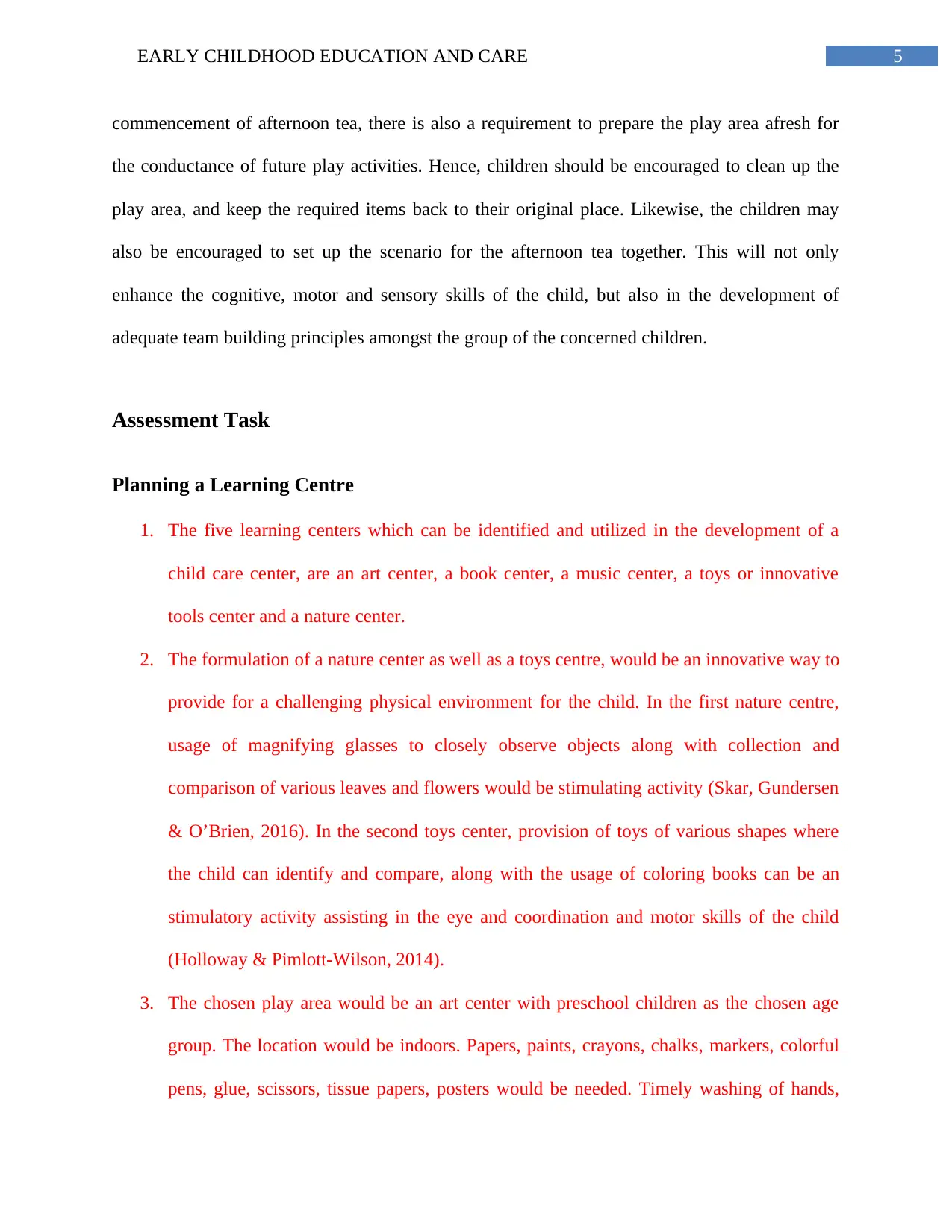
5EARLY CHILDHOOD EDUCATION AND CARE
commencement of afternoon tea, there is also a requirement to prepare the play area afresh for
the conductance of future play activities. Hence, children should be encouraged to clean up the
play area, and keep the required items back to their original place. Likewise, the children may
also be encouraged to set up the scenario for the afternoon tea together. This will not only
enhance the cognitive, motor and sensory skills of the child, but also in the development of
adequate team building principles amongst the group of the concerned children.
Assessment Task
Planning a Learning Centre
1. The five learning centers which can be identified and utilized in the development of a
child care center, are an art center, a book center, a music center, a toys or innovative
tools center and a nature center.
2. The formulation of a nature center as well as a toys centre, would be an innovative way to
provide for a challenging physical environment for the child. In the first nature centre,
usage of magnifying glasses to closely observe objects along with collection and
comparison of various leaves and flowers would be stimulating activity (Skar, Gundersen
& O’Brien, 2016). In the second toys center, provision of toys of various shapes where
the child can identify and compare, along with the usage of coloring books can be an
stimulatory activity assisting in the eye and coordination and motor skills of the child
(Holloway & Pimlott-Wilson, 2014).
3. The chosen play area would be an art center with preschool children as the chosen age
group. The location would be indoors. Papers, paints, crayons, chalks, markers, colorful
pens, glue, scissors, tissue papers, posters would be needed. Timely washing of hands,
commencement of afternoon tea, there is also a requirement to prepare the play area afresh for
the conductance of future play activities. Hence, children should be encouraged to clean up the
play area, and keep the required items back to their original place. Likewise, the children may
also be encouraged to set up the scenario for the afternoon tea together. This will not only
enhance the cognitive, motor and sensory skills of the child, but also in the development of
adequate team building principles amongst the group of the concerned children.
Assessment Task
Planning a Learning Centre
1. The five learning centers which can be identified and utilized in the development of a
child care center, are an art center, a book center, a music center, a toys or innovative
tools center and a nature center.
2. The formulation of a nature center as well as a toys centre, would be an innovative way to
provide for a challenging physical environment for the child. In the first nature centre,
usage of magnifying glasses to closely observe objects along with collection and
comparison of various leaves and flowers would be stimulating activity (Skar, Gundersen
& O’Brien, 2016). In the second toys center, provision of toys of various shapes where
the child can identify and compare, along with the usage of coloring books can be an
stimulatory activity assisting in the eye and coordination and motor skills of the child
(Holloway & Pimlott-Wilson, 2014).
3. The chosen play area would be an art center with preschool children as the chosen age
group. The location would be indoors. Papers, paints, crayons, chalks, markers, colorful
pens, glue, scissors, tissue papers, posters would be needed. Timely washing of hands,
⊘ This is a preview!⊘
Do you want full access?
Subscribe today to unlock all pages.

Trusted by 1+ million students worldwide
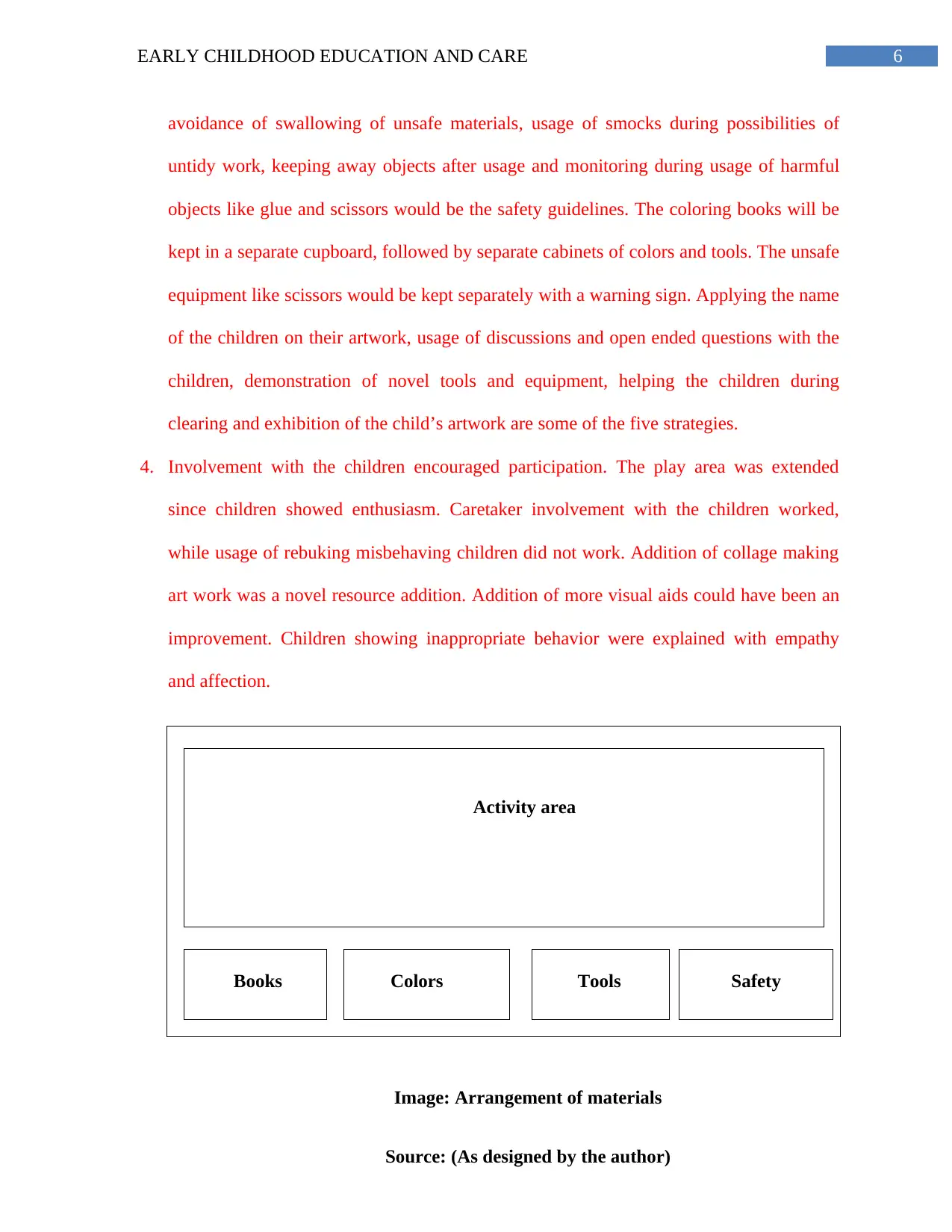
6EARLY CHILDHOOD EDUCATION AND CARE
avoidance of swallowing of unsafe materials, usage of smocks during possibilities of
untidy work, keeping away objects after usage and monitoring during usage of harmful
objects like glue and scissors would be the safety guidelines. The coloring books will be
kept in a separate cupboard, followed by separate cabinets of colors and tools. The unsafe
equipment like scissors would be kept separately with a warning sign. Applying the name
of the children on their artwork, usage of discussions and open ended questions with the
children, demonstration of novel tools and equipment, helping the children during
clearing and exhibition of the child’s artwork are some of the five strategies.
4. Involvement with the children encouraged participation. The play area was extended
since children showed enthusiasm. Caretaker involvement with the children worked,
while usage of rebuking misbehaving children did not work. Addition of collage making
art work was a novel resource addition. Addition of more visual aids could have been an
improvement. Children showing inappropriate behavior were explained with empathy
and affection.
Activity area
Books Colors Tools Safety
Image: Arrangement of materials
Source: (As designed by the author)
avoidance of swallowing of unsafe materials, usage of smocks during possibilities of
untidy work, keeping away objects after usage and monitoring during usage of harmful
objects like glue and scissors would be the safety guidelines. The coloring books will be
kept in a separate cupboard, followed by separate cabinets of colors and tools. The unsafe
equipment like scissors would be kept separately with a warning sign. Applying the name
of the children on their artwork, usage of discussions and open ended questions with the
children, demonstration of novel tools and equipment, helping the children during
clearing and exhibition of the child’s artwork are some of the five strategies.
4. Involvement with the children encouraged participation. The play area was extended
since children showed enthusiasm. Caretaker involvement with the children worked,
while usage of rebuking misbehaving children did not work. Addition of collage making
art work was a novel resource addition. Addition of more visual aids could have been an
improvement. Children showing inappropriate behavior were explained with empathy
and affection.
Activity area
Books Colors Tools Safety
Image: Arrangement of materials
Source: (As designed by the author)
Paraphrase This Document
Need a fresh take? Get an instant paraphrase of this document with our AI Paraphraser
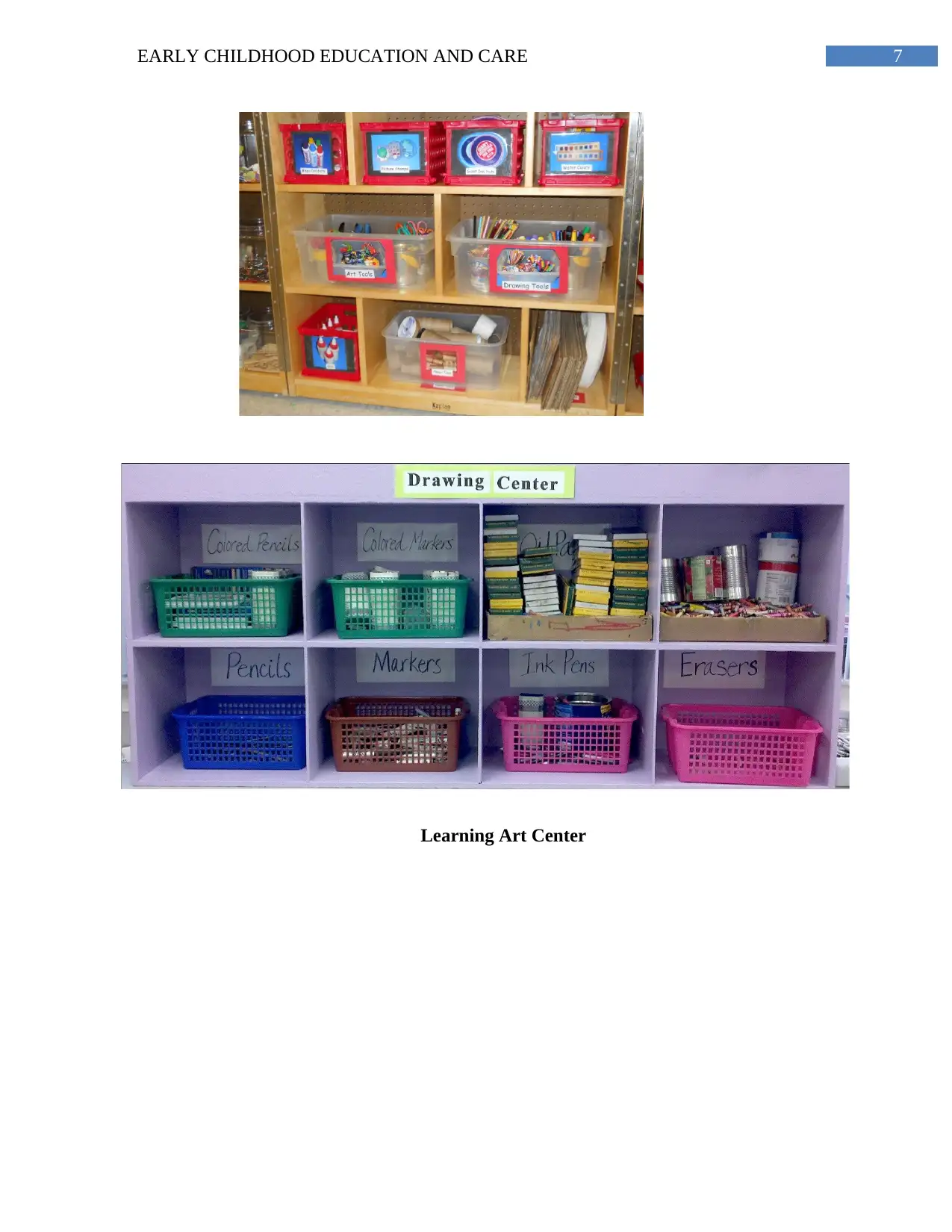
7EARLY CHILDHOOD EDUCATION AND CARE
Learning Art Center
Learning Art Center
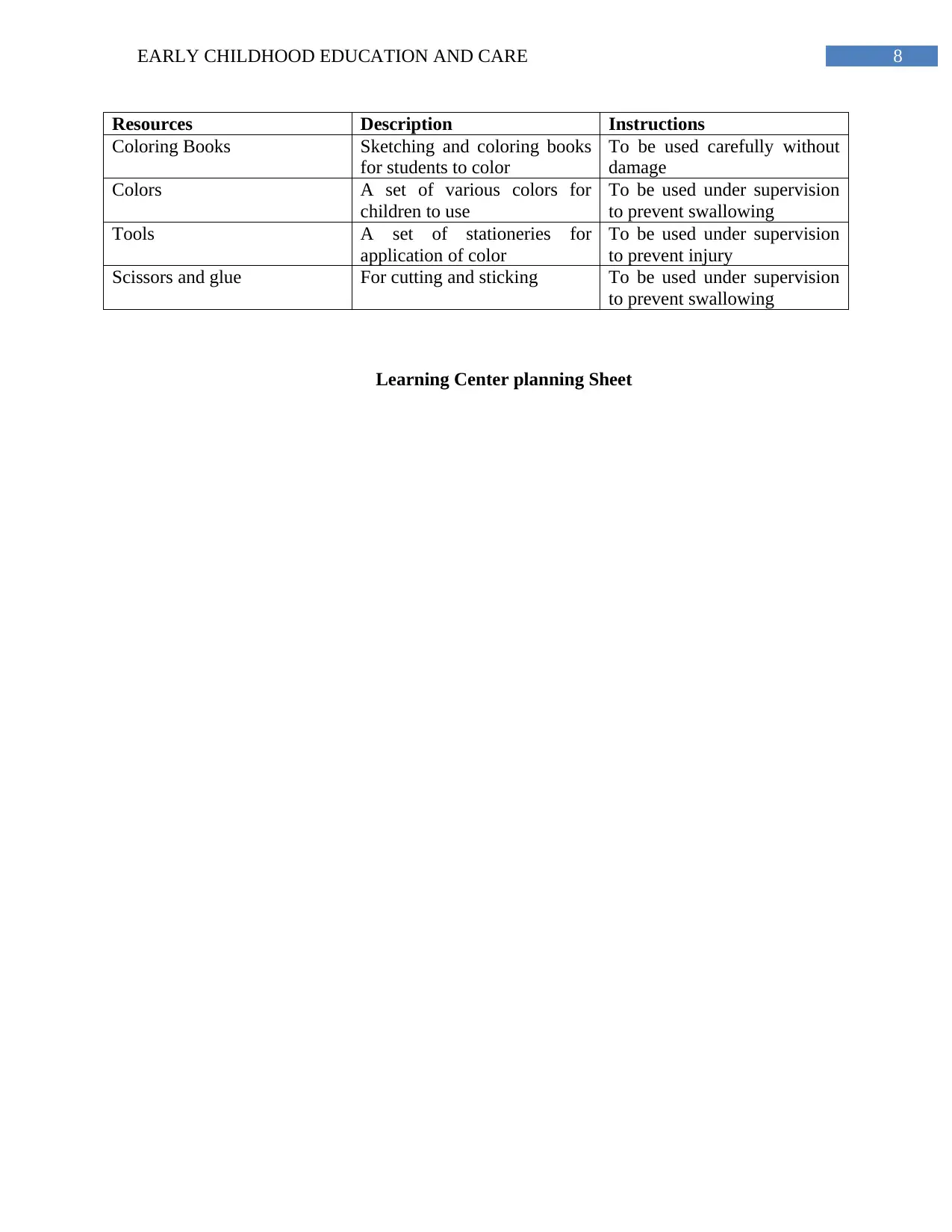
8EARLY CHILDHOOD EDUCATION AND CARE
Resources Description Instructions
Coloring Books Sketching and coloring books
for students to color
To be used carefully without
damage
Colors A set of various colors for
children to use
To be used under supervision
to prevent swallowing
Tools A set of stationeries for
application of color
To be used under supervision
to prevent injury
Scissors and glue For cutting and sticking To be used under supervision
to prevent swallowing
Learning Center planning Sheet
Resources Description Instructions
Coloring Books Sketching and coloring books
for students to color
To be used carefully without
damage
Colors A set of various colors for
children to use
To be used under supervision
to prevent swallowing
Tools A set of stationeries for
application of color
To be used under supervision
to prevent injury
Scissors and glue For cutting and sticking To be used under supervision
to prevent swallowing
Learning Center planning Sheet
⊘ This is a preview!⊘
Do you want full access?
Subscribe today to unlock all pages.

Trusted by 1+ million students worldwide
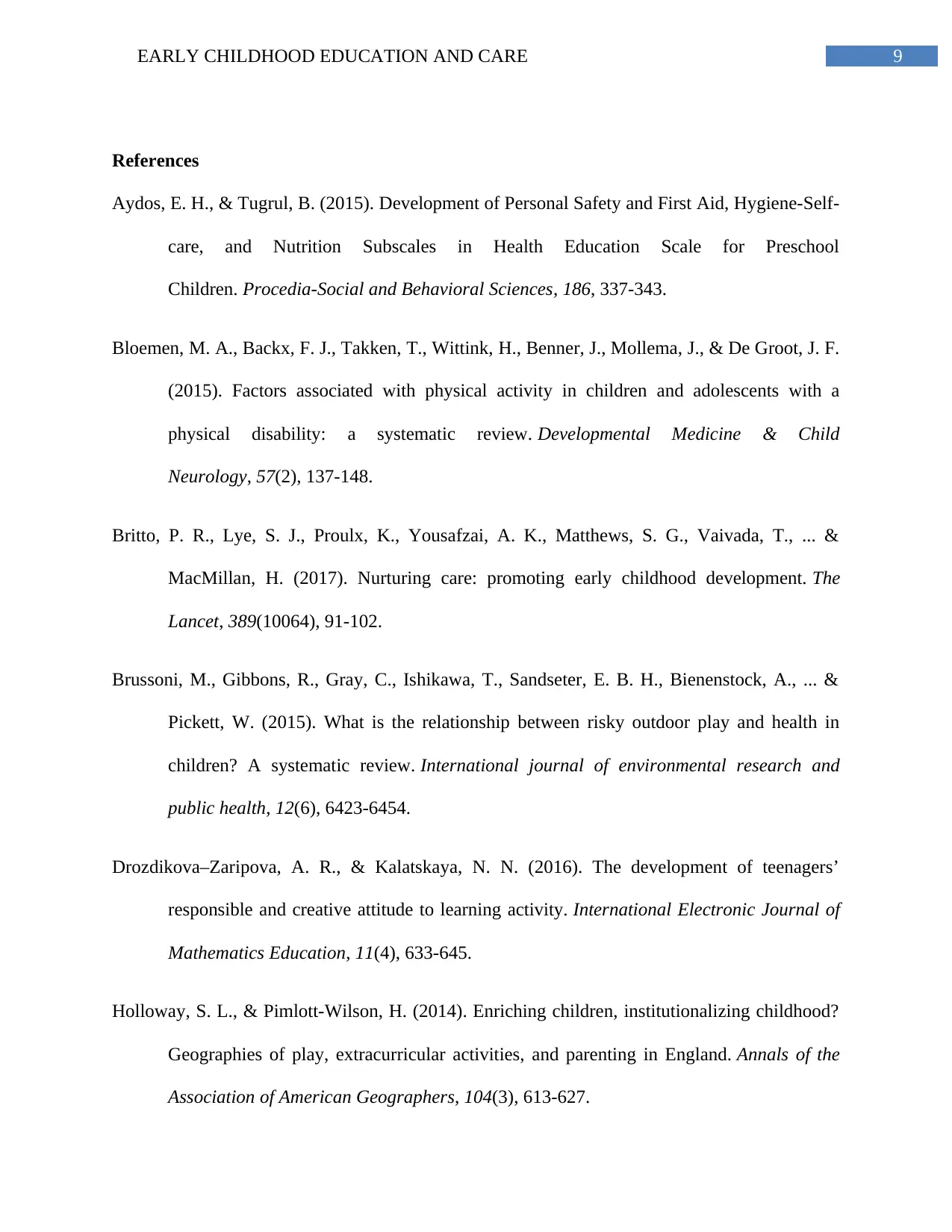
9EARLY CHILDHOOD EDUCATION AND CARE
References
Aydos, E. H., & Tugrul, B. (2015). Development of Personal Safety and First Aid, Hygiene-Self-
care, and Nutrition Subscales in Health Education Scale for Preschool
Children. Procedia-Social and Behavioral Sciences, 186, 337-343.
Bloemen, M. A., Backx, F. J., Takken, T., Wittink, H., Benner, J., Mollema, J., & De Groot, J. F.
(2015). Factors associated with physical activity in children and adolescents with a
physical disability: a systematic review. Developmental Medicine & Child
Neurology, 57(2), 137-148.
Britto, P. R., Lye, S. J., Proulx, K., Yousafzai, A. K., Matthews, S. G., Vaivada, T., ... &
MacMillan, H. (2017). Nurturing care: promoting early childhood development. The
Lancet, 389(10064), 91-102.
Brussoni, M., Gibbons, R., Gray, C., Ishikawa, T., Sandseter, E. B. H., Bienenstock, A., ... &
Pickett, W. (2015). What is the relationship between risky outdoor play and health in
children? A systematic review. International journal of environmental research and
public health, 12(6), 6423-6454.
Drozdikova–Zaripova, A. R., & Kalatskaya, N. N. (2016). The development of teenagers’
responsible and creative attitude to learning activity. International Electronic Journal of
Mathematics Education, 11(4), 633-645.
Holloway, S. L., & Pimlott-Wilson, H. (2014). Enriching children, institutionalizing childhood?
Geographies of play, extracurricular activities, and parenting in England. Annals of the
Association of American Geographers, 104(3), 613-627.
References
Aydos, E. H., & Tugrul, B. (2015). Development of Personal Safety and First Aid, Hygiene-Self-
care, and Nutrition Subscales in Health Education Scale for Preschool
Children. Procedia-Social and Behavioral Sciences, 186, 337-343.
Bloemen, M. A., Backx, F. J., Takken, T., Wittink, H., Benner, J., Mollema, J., & De Groot, J. F.
(2015). Factors associated with physical activity in children and adolescents with a
physical disability: a systematic review. Developmental Medicine & Child
Neurology, 57(2), 137-148.
Britto, P. R., Lye, S. J., Proulx, K., Yousafzai, A. K., Matthews, S. G., Vaivada, T., ... &
MacMillan, H. (2017). Nurturing care: promoting early childhood development. The
Lancet, 389(10064), 91-102.
Brussoni, M., Gibbons, R., Gray, C., Ishikawa, T., Sandseter, E. B. H., Bienenstock, A., ... &
Pickett, W. (2015). What is the relationship between risky outdoor play and health in
children? A systematic review. International journal of environmental research and
public health, 12(6), 6423-6454.
Drozdikova–Zaripova, A. R., & Kalatskaya, N. N. (2016). The development of teenagers’
responsible and creative attitude to learning activity. International Electronic Journal of
Mathematics Education, 11(4), 633-645.
Holloway, S. L., & Pimlott-Wilson, H. (2014). Enriching children, institutionalizing childhood?
Geographies of play, extracurricular activities, and parenting in England. Annals of the
Association of American Geographers, 104(3), 613-627.
Paraphrase This Document
Need a fresh take? Get an instant paraphrase of this document with our AI Paraphraser
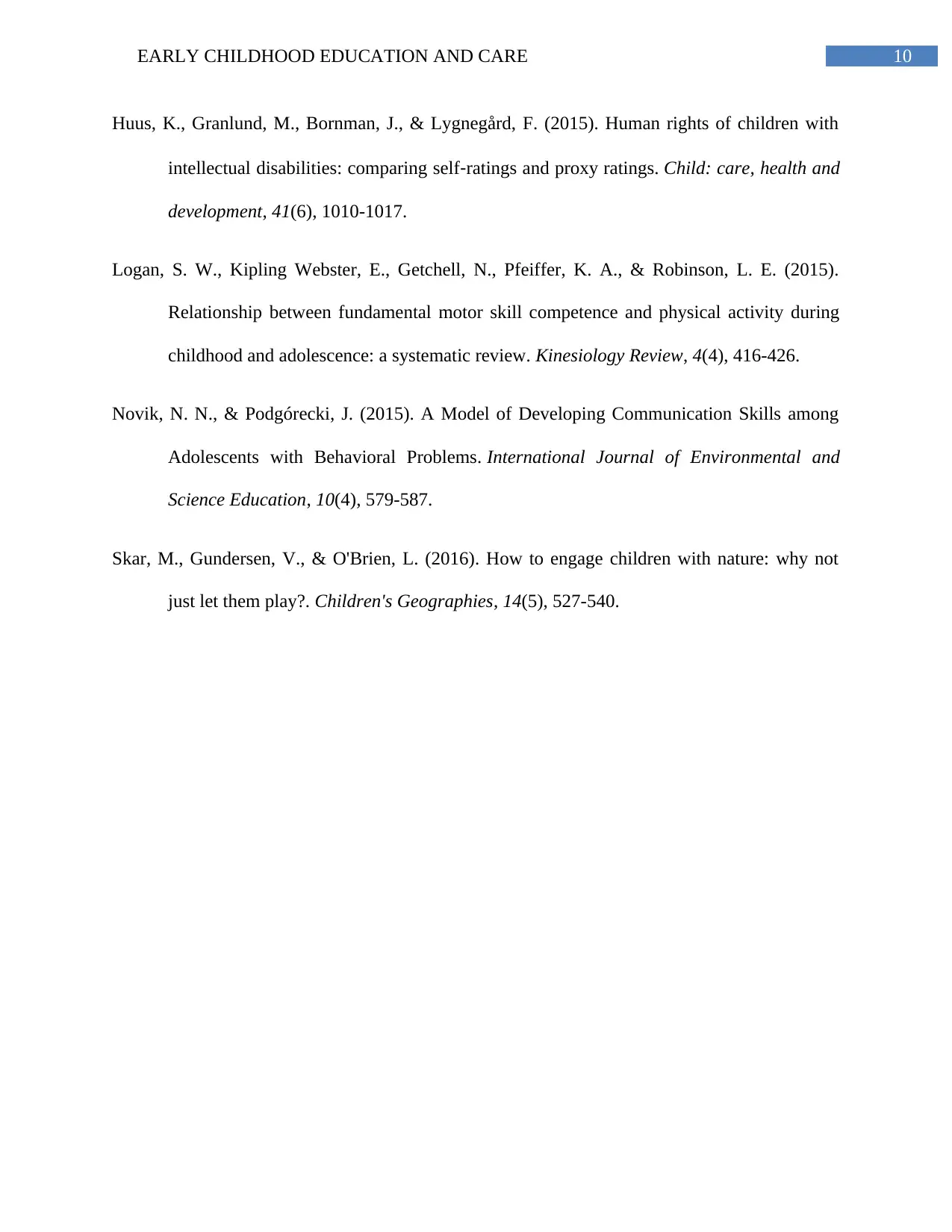
10EARLY CHILDHOOD EDUCATION AND CARE
Huus, K., Granlund, M., Bornman, J., & Lygnegård, F. (2015). Human rights of children with
intellectual disabilities: comparing self‐ratings and proxy ratings. Child: care, health and
development, 41(6), 1010-1017.
Logan, S. W., Kipling Webster, E., Getchell, N., Pfeiffer, K. A., & Robinson, L. E. (2015).
Relationship between fundamental motor skill competence and physical activity during
childhood and adolescence: a systematic review. Kinesiology Review, 4(4), 416-426.
Novik, N. N., & Podgórecki, J. (2015). A Model of Developing Communication Skills among
Adolescents with Behavioral Problems. International Journal of Environmental and
Science Education, 10(4), 579-587.
Skar, M., Gundersen, V., & O'Brien, L. (2016). How to engage children with nature: why not
just let them play?. Children's Geographies, 14(5), 527-540.
Huus, K., Granlund, M., Bornman, J., & Lygnegård, F. (2015). Human rights of children with
intellectual disabilities: comparing self‐ratings and proxy ratings. Child: care, health and
development, 41(6), 1010-1017.
Logan, S. W., Kipling Webster, E., Getchell, N., Pfeiffer, K. A., & Robinson, L. E. (2015).
Relationship between fundamental motor skill competence and physical activity during
childhood and adolescence: a systematic review. Kinesiology Review, 4(4), 416-426.
Novik, N. N., & Podgórecki, J. (2015). A Model of Developing Communication Skills among
Adolescents with Behavioral Problems. International Journal of Environmental and
Science Education, 10(4), 579-587.
Skar, M., Gundersen, V., & O'Brien, L. (2016). How to engage children with nature: why not
just let them play?. Children's Geographies, 14(5), 527-540.
1 out of 11
Related Documents
Your All-in-One AI-Powered Toolkit for Academic Success.
+13062052269
info@desklib.com
Available 24*7 on WhatsApp / Email
![[object Object]](/_next/static/media/star-bottom.7253800d.svg)
Unlock your academic potential
Copyright © 2020–2025 A2Z Services. All Rights Reserved. Developed and managed by ZUCOL.





